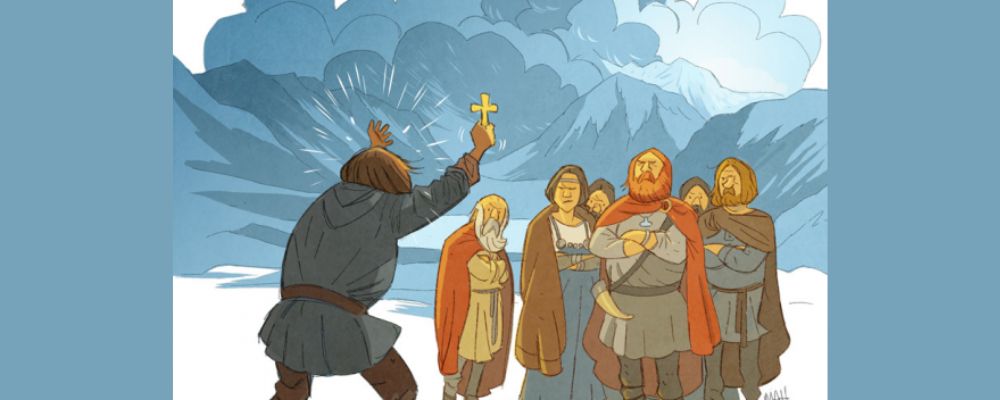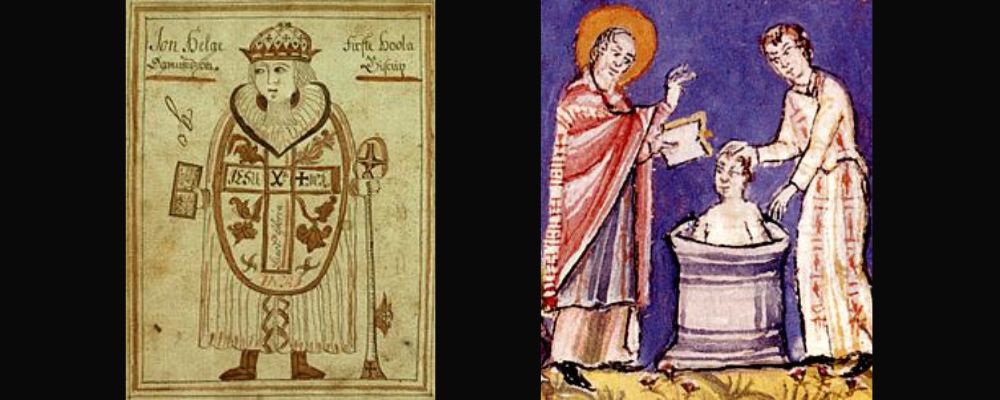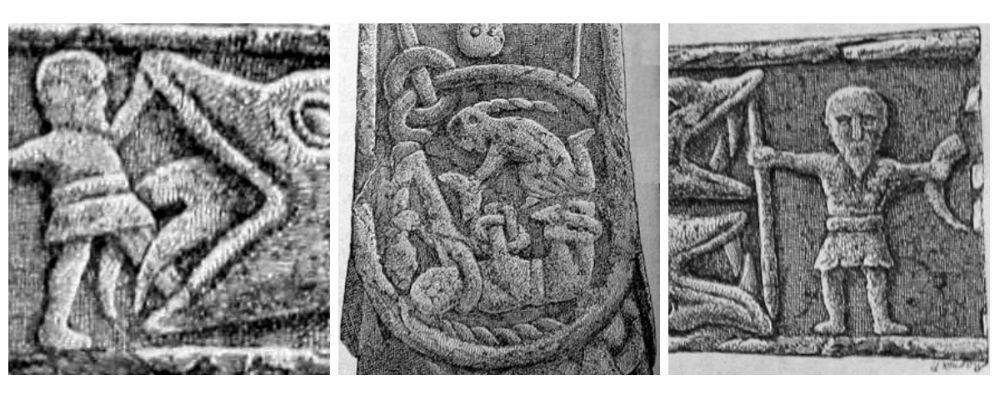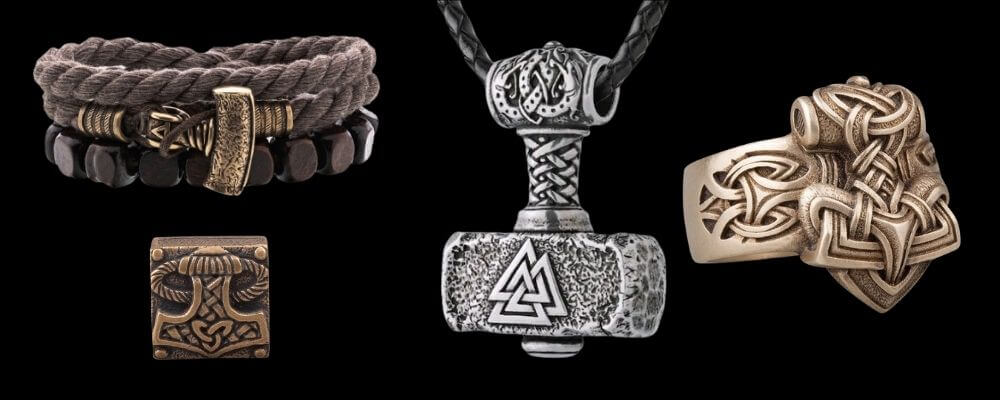The great Viking era began in the 700s when Viking ship technology advanced to the point where they could successfully raid their European neighbors and colonize new lands in the North Atlantic Sea.
The Viking Age ended when the Pagan warrior clans had transformed into Christian states under strong kings who developed political relationships with their powerful Christian neighbors and the influential Church.
But when, why, and how did the Vikings convert to Christianity?

Viking Hagiography
Hagiography is the literary tradition of writing about saints and other important Christian figures. If these sources are to be believed, great men, missionary monks, and Viking kings inspired to convert were largely responsible for the conversion of the Viking world in a top-down manner.
According to this hagiography, missionaries were already active in the Viking homelands in the 8th and 9th centuries but had limited influence. True conversion happened in the 10th and 11th centuries, mostly when the kings converted.
In these stories, Christianity is a political tool, with Christian king succeeded by Pagan king, succeeded by Christian king, each converting the population over which they ruled.

Denmark
In Denmark, Harald Bluetooth is the key figure. He was the son of the Pagan king Gorm the Old, but his mother, the queen Thyra, was Christian. Both Pagan and Christian imagery is seen in their double burial harrow at Jelling.
Harald is said to have nominally converted to Christianity in the 930s in order to form alliances with his powerful German neighbors, who were Christians. He converted sincerely in the 960s when a missionary monk named Poppo held a burning hot iron in his hand without injuring himself. Bluetooth moved his capital from the Pagan center at Jelling to Roskilde on the island of Zealand.
His son Sweyn Forkbeard, who had been baptized, rebelled against his father and tried to set himself up as an opposing Pagan ruler in Jelling. He may principally have leveraged Paganism as a way to differentiate himself from his father and justify his actions.
It is often mentioned that Sweyn Forkbeard destroyed many churches in England. But this was part of his response to the St Bryce’s Day Massacre in 1002, which saw the English slaughter thousands of Danes on the island. Once Sweyn Forkbeard had reasserted control in England, he was tolerant of Christianity there.
Meanwhile, Christianity was still making inroads in Denmark. King Canute IV was ousted from power in 1086 because he was not using traditional Thing gatherings, which were intimately linked with Pagan rituals, to pass new laws. Instead he was passing them on his own authority. There were also complaints about tithes to pay for new monasteries and other Christian cult centers.While the Danish of the late 11th century complained about these actions, they did not seem to have a problem with Christianity specifically. Canute was canonized in 1188, by which time Denmark was thoroughly Christianized.

Norway (Iceland and Greenland)
In Norway, the story of conversion is linked with Haakon the Good in the 10th century. He grew up as a hostage at the court in England and so would have been a Christian. When he succeeded to the Norwegian throne, he brought his religion with him, but seems happy to have let Christianity and Paganism exist side-by-side.
While his successors variously razed and built Pagan temples, the next important figure is Olaf Tryggvason, who became king in 995. According to his hagiography, he converted to Christianity after encountering a Christian Seer on the Isles of Scilly. When he became king of Norway, he actively converted by all means at his disposal.
It was his zealousness that led to the official conversion of Iceland and Greenland, which were principally colonized by Norwegian Vikings.
Iceland seems to already have had Christians among its settlers when then began to arrive in the 9th century. Religious freedom may have been one of the motives for settlers who struck out for the new land. Nevertheless, Olaf sent missionaries to forcibly convert the Icelanders, which caused great divides in the community.
According to the surviving hagiography, the Icelandic leaders decided that Iceland needed to unite if it was to remain independent from Norway, and this meant that it needed religious unity. They decided that everyone should be baptized but that private Pagan practices would be tolerated. Nevertheless, laws would later be passed outlawing certain Pagan activities.
In Greenland, Leif Erikson, the son of the colony’s founder and leader Erik the Red, would spend time in Norway with Olaf and convert to Christianity. It would have been relatively easy for Leif to begin the process of conversion in Greenland, especially when he became leader following the death of his Pagan father. He was a highly influential leader in a very small community.

Sweden
In Sweden, King Olof Skotkung converted to Christianity and in around 990 drew up an agreement of mutual religious tolerance with the powerful Pagan religious leaders at Uppsala. He built his Christian religious seat at Skara in Vastergotland. Around 1140 the seat was moved to Gamla Uppsala, suggesting that the Pagan community had largely accepted Christianity by this time.
In Sweden, there are fewer clear stories about converting kings. But we do hear about a conflict between the Christian king Inge the Elder and the Pagan king Blot-Sweyn in the 1080s. The former was exiled for trying to end Pagan traditions and then returned and burned down the home of Blot-Sweyn and killed him before retaking power.

Why Did the Viking Kings Convert?
In the 10th and 11th centuries, the Viking leadership would have had very good reasons to convert. Getting baptized, whether for faith or just for show, was essential to forming alliances with powerful neighbors in Germany, France, and England, who could only form alliances with other Christian leaders.
Viking leaders, who were consolidating relatively small chieftainships into large kingdoms, would also have seen the power conferred by kingship by “divine right” exercised in the Christian world and the support of the wealthy and powerful church in maintaining power. This offered advantages over rulership via the Thing, which required gathering powerful nobles and ruling by common consent.
Furthermore, the system of administration and writing used within the church was vital for running large states, and by converting, the kings gained access to these resources.
There is also no denying that the Church was extremely wealthy, something that the Vikings would have been very aware of since they raided the Lindisfarne monastery in the 8th century. They would have recognized that Christianity offered access to that wealth.
When Viking kings demanded that their people convert to Christianity, being baptized probably represented a way of accepting the new structure of kingship and showing allegiance to the newly established centralized leadership.
Most kings probably cared little about the individual religious practices of Viking farmers inside their own homes. However, in time, the Church may have put pressure on the Viking kings to actively suppress Paganism. They would at least have wanted to appear to do this to maintain the support of their new allies.
Many other Vikings would have converted for similar political reasons. Nobles would have converted to gain favor with the king. Similarly, traders may have, at least outwardly, converted to Christianity since most Christian traders were only permitted to do business with other Christians.It is interesting that populations with less political interest in the area, for example the Finnish Sami, did not convert until much later. The Sami do not appear to have converted until the 18th century, despite missionary work from the neighbors.

Why did Regular Vikings Convert?
But the move from Paganism to Christianity had to be more than just a political movement to really take root in Viking culture. So why did other Vikings, with fewer political interests, move from worshiping the Old Norse gods to Christianity.
The Vikings would have been aware of Christianity for centuries, since most of their neighbors were Christian. There is good evidence that many Vikings believed that the Christian god was indeed a divinity, but just one of the many that existed. Initially, they had no particular reason to start worshiping this foreign deity in place of the local gods that had always served them well.
The Vikings that moved to other parts of Europe, such as England and France, seem to have converted quite quickly. This may be linked to the idea that gods have physical or geographic domains. In new territories, the local gods of that territory are powerful. It would have been sensible to participate in local religions practices and within a few generations of intermarriage adopt them.
This doesn’t mean that traditional religion was completely forgotten. The 10th century Gosforth Cross from a Viking community in England is clearly a Christian monument, but shows imagery from Norse mythology.
It was incorporating these new religious ideas into practices “back home” that would have been challenging.
But contact with Christian ideals in the Viking homeland would have been increasing from the 8th century onwards as Christian slaves and Christian wives were brought over and as there was contact with Christian Viking colonies in places like England. But the penetration of these new ideas would have been slow.
There is good evidence to suggest that when kings demanded that their people converted, the locals might agree to be baptized, often enticed by wealthy gifts that accompanied the ritual, but continued Pagan worship within their own homes and local communities. Archaeological evidence suggests that conversion was a gradual process that took almost 200 years over the 10th and 11th centuries.
Compelling evidence that Christianity and Paganism managed to find a way to coexist relatively peacefully during this period in Scandinavia are soapstone molds used by blacksmiths. There are examples from Denmark and Sweden that show Christian cross symbols and Thor’s hammer symbols in the same mold.
The fact that Christianity came out “on top” probably has less to do with it being a more compelling religion for ordinary people and more to do with the Europeanization of the Vikings. As they had more contact with their European neighbors, and increasingly peaceful contact, cultural exchange was inevitable. It included everything from fashion, to literature, to farming techniques. Christianity was very much a part of what it meant to be European at the time, so it also came along when other cultural ideas were adopted.That is not to say that the influence did not work both ways. We have already discussed on this blog the immense influence that the Viking religions festival of Jol had on the development of Christmas, and this is just one of many examples.

What do you Think?
What do you think of the widespread conversion of the Vikings to Christianity in the 10th and 11th centuries?
Many modern commentators point out that while most Scandinavians today say they believe in “something” they are not closely tied to the Christian faith. The suggestion is that the adoption of Christianity was always, in some ways, superficial and just applying Christian window dressing to a deeper spirituality.
This may explain why the Old Norse religion, in the guise of Asatru, Heathenry, or under some other name, has made a compelling comeback in Scandinavia over the last century.
For most modern followers of the Old Norse religion, wearing a Thor’s Hammer pendant is a sign of this affiliation. Why not check out some of the Thor’s Hammer pieces available in the VKNG store.








